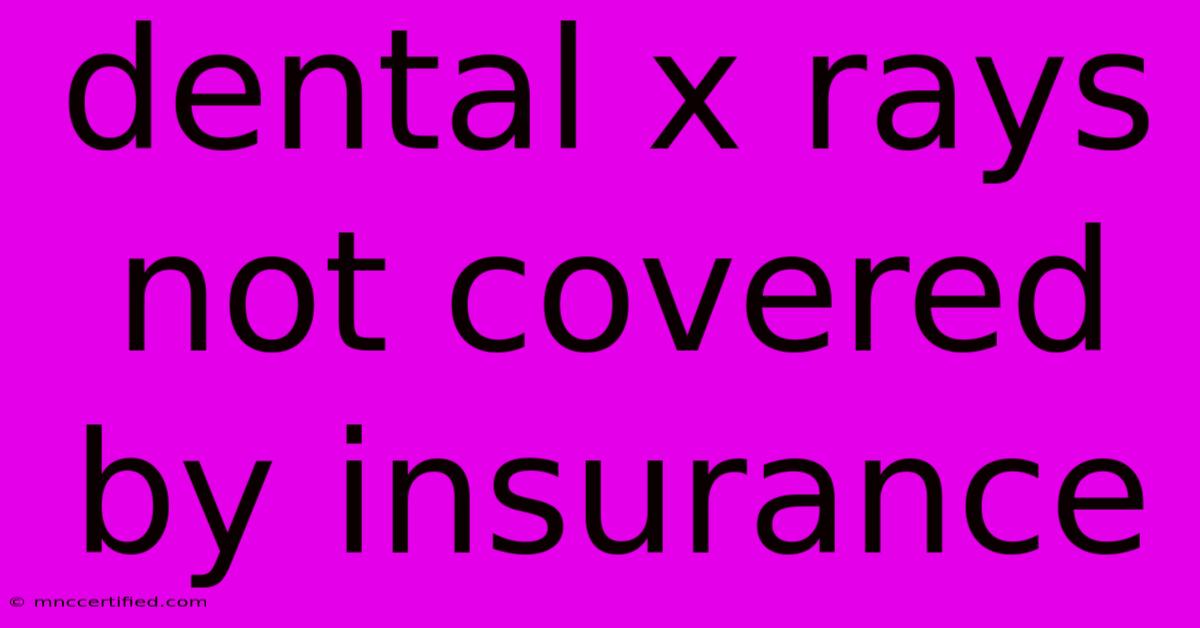Dental X Rays Not Covered By Insurance

Table of Contents
Dental X-Rays: When Insurance Doesn't Cover the Cost
Dental x-rays are an essential part of maintaining good oral health. They allow dentists to detect problems that may not be visible during a regular examination, such as cavities, bone loss, and impacted teeth. However, many people are surprised to find that their dental insurance doesn't cover the cost of all x-rays, leaving them with unexpected expenses.
Why Dental Insurance May Not Cover X-Rays
There are several reasons why your dental insurance may not fully cover x-ray costs:
- Frequency limitations: Most dental insurance plans have limitations on how often you can get certain types of x-rays. For example, you might only be eligible for a full set of x-rays (also known as a panoramic or bitewing) every 2-3 years.
- Preventive vs. diagnostic: Insurance plans typically cover preventive x-rays, such as those taken during your routine checkup. However, diagnostic x-rays, which are taken to investigate a specific problem, may not be fully covered.
- Specific coverage: Some insurance plans have specific coverage for certain types of x-rays. For example, you might be fully covered for bitewing x-rays but not for periapical x-rays.
- Pre-existing conditions: If you have a pre-existing condition that requires frequent x-rays, your insurance may not cover the costs beyond a certain limit.
Understanding Your Coverage
The first step to avoiding unexpected costs is understanding your dental insurance coverage. Here's how to find out if x-rays are covered:
- Review your policy: Carefully read your policy document to understand the specific coverage for x-rays. Pay attention to the frequency limitations, types of x-rays covered, and any exclusions.
- Contact your insurance provider: Call your insurance company and speak to a representative about your x-ray coverage. They can provide you with detailed information about your plan's limitations and any additional costs you may incur.
What to Do When X-Rays Aren't Covered
If your insurance doesn't cover the full cost of x-rays, here are some options:
- Negotiate with your dentist: Some dentists are willing to work with patients to reduce the cost of x-rays, especially if they have a good relationship with their patients.
- Ask about payment plans: Many dental practices offer flexible payment plans or financing options to help patients manage the cost of care.
- Consider a different insurance plan: If you're frequently facing uncovered x-ray costs, consider changing to a dental insurance plan that offers more comprehensive coverage.
- Shop around for dentists: Compare the prices of x-rays at different dental practices in your area. You may find a practice that offers lower prices or has a payment plan that works for you.
Preventing Unnecessary X-Rays
While x-rays are crucial for maintaining oral health, they also involve exposure to low levels of radiation. To minimize your exposure, follow these tips:
- Ask your dentist about the necessity of x-rays: Don't hesitate to question your dentist about the need for x-rays, especially if you haven't had them recently.
- Keep your regular appointments: Regular checkups help your dentist monitor your oral health and determine if x-rays are truly necessary.
Conclusion
Navigating dental insurance coverage can be tricky, especially when it comes to x-rays. By understanding your policy, communicating with your insurance provider and dentist, and considering your options, you can minimize the financial burden of essential dental care. Remember, prioritizing oral health is crucial, but you don't have to compromise your financial stability.
Keywords: Dental X-Rays, Insurance Coverage, Dental Insurance, Uncovered Costs, X-Ray Costs, Frequency Limitations, Preventive X-rays, Diagnostic X-rays, Dental Care Costs, Financial Burden, Oral Health, Dental Appointments

Thank you for visiting our website wich cover about Dental X Rays Not Covered By Insurance. We hope the information provided has been useful to you. Feel free to contact us if you have any questions or need further assistance. See you next time and dont miss to bookmark.
Featured Posts
-
Gold Bond Ultimate Comfort Body Powder
Nov 09, 2024
-
Spicy Mc Nuggets And 1 Deal At Mc Donald S
Nov 09, 2024
-
James Bond Agent Under Fire Ps2 Cheats
Nov 09, 2024
-
Frank Hickeys Horse Racing Bets 25 1 Play
Nov 09, 2024
-
Understanding Seed To Tables Politics
Nov 09, 2024